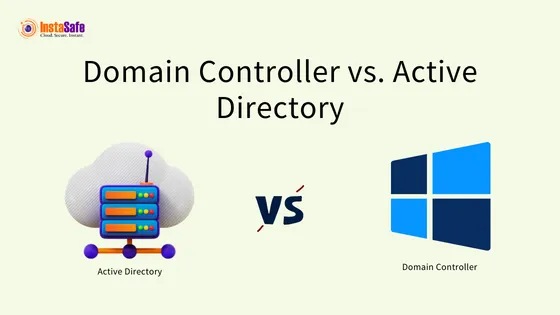Domain Controller vs Active Directory: What's the Difference

A domain controller is a server that handles authentication requests and enforces security policies, whereas an Active Directory is a directory service that stores and organises information about network resources, users, and devices.
Active Directory (AD) and Domain Controllers are essential components for organisations utilising Windows operating systems. However, it can be confusing to differentiate between the two.
Active Directory is a proprietary directory service provided by Microsoft, which enables IT teams to manage identity and secure access to various resources across an enterprise network.
Conversely, a Domain Controller is a server that acknowledges user authentication requests, enabling the host to obtain various resources on the business network.
This article will examine and outline all the discrepancies between Domain Controller vs Active Directory.
Active Directory vs. Domain Controller
Active Directory and Domain Controller are closely related but distinct components in Windows Server environments.
Definitions:
What is Active Directory? - Active Directory is a database that stores and organises information about network resources, users and devices as objects. It provides a centralised location for managing identities, access controls and policies.
What is a Domain Controller? - A Domain Controller is simply a server that runs Active Directory and verifies users and devices. In this sense, a Domain Controller is a custodian, host, or facilitator of Active Directory.
Functionality:
- The primary purpose of Active Directory is to systematically store information about all resources and users in a well-organised manner.
- Conversely, the Domain Controller's primary responsibility is to verify and authenticate user access to resources.
Key Differences:
- The key differences between a domain controller and Active Directory, can be seen through their functionality – Domain Controllers are the enforcers of the rules and policies defined within the Active Directory environment.

Domain Controller vs Active Directory Server: Illustration
The main difference between a Domain Controller and an Active Directory, is that an Active Directory (AD) manages your identity and gives secure access while Domain Controllers verify your authority.
Consider this example: To log in to your computer, you must first verify your identity and establish your authority.
Now, your computer is registered as a domain member and has been verified through its unique SID (security identity), allowing you to access network resources. Verification involves exchanging security keys between your computer and the Domain Controller.
Once verified, you can enter your username linked to your user account. Your account has its own SID, and the security principal assigns your access rights for local logon. Additionally, your Microsoft Outlook program is pre-configured to use your company's Exchange server.
So, where is all of this data stored? Active Directory stores all of your information, including your computer account's data, such as its location and management information.
Understanding Active Directory
- Active Directory is an identity management database that enables IT teams to regulate user access on a network. It is a database that stores data in the form of objects.
- These objects can be individual resources such as users, groups, applications, or devices, each with its own associated attributes that distinguish it from other entities.
- For instance, a user object would have attributes such as a username, password, and email that separate it from other objects.
- Aside from storing information, Active Directory is also used to maintain network processes in large organisations and to permit specific users, thereby providing conditional access for enhanced security.
Understanding Domain Controller
- A Domain Controller is responsible for controlling access to enterprise resources within a specific domain by verifying and authorising users based on their login credentials.
- The domain acts as a central location for administrative work and security policies, with each domain having a separate database account managed by an admin who handles all objects within that domain.
- For instance, in Windows domains, the domain controller obtains user account authentication information from Active Directory.
- Since Domain Controllers control all access to network resources, enhancing their security with additional measures like firewalls, encryption protocols, and accelerated configuration and patch management solutions is critical.
Conclusion
As discussed, the key difference between a Domain Controller and an Active Directory is that a Domain Controller is responsible for verifying user credentials in the Active Directory, allowing them to join the domain. Implementing Domain Controllers and selecting the appropriate service is critical to enhancing network security and safeguarding user data. If you require a service to securely connect remote employee devices to your corporate domain, check out InstaSafe solutions. Schedule a demo today to learn more about us!
Key Products
Multi Factor Authentication | Identity And Access Management | ZTNA | Zero Trust Application Access | Secure Enterprise Browser
Key Features
Single Sign On | Endpoint Security | Device Binding | Domain Joining | Always On VPN | Contextual Access | Clientless Remote Access | Device Posture Check
Key Solutions
VPN Alternatives | DevOps Security | Cloud Application Security | Secure Remote Access | VoIP Security
